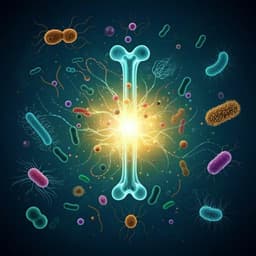
Earth Sciences
High resolution ancient sedimentary DNA shows that alpine plant diversity is associated with human land use and climate change
S. Garcés-pastor, E. Coissac, et al.
This intriguing study explores the interplay of vegetation, temperature, and human impact in the European Alps over 12,000 years, revealing how agropastoral activities may enhance alpine plant diversity. Conducted by an expert team of researchers, it combines ancient DNA analysis and sedimentary records to shed light on environmental changes.
~3 min • Beginner • English
Introduction
Mountain vegetation is structured by temperature, moisture, landforms, and geomorphology across elevational belts, but millennia of human land use have also shaped diversity. Climate warming is expected to drive upward shifts of vegetation, reducing alpine habitats, while recent land abandonment has increased forest cover and reduced meadow species. Traditional palaeoecological proxies, particularly pollen, underrepresent many forbs and graminoids due to low pollen production and limited taxonomic resolution. Sedimentary ancient DNA (sedaDNA) offers improved detection of herbaceous taxa and taxonomic resolution. The European Alps, a biodiversity hotspot with ~4000 native plant species and many endemics, have experienced human influence since the Mesolithic, including forest clearance and agropastoralism since the Neolithic, creating a mosaic of species-rich habitats. The study aims to reconstruct vegetation around Lake Sulsseewli (northern Swiss Alps) over the last ~12,000 years, disentangle climatic versus human drivers of diversity, and assess how these factors shaped elevational vegetation belts and present-day richness.
Literature Review
Prior work shows alpine plant communities respond strongly to temperature and moisture regimes and that human activities (e.g., grazing, burning, agriculture) have long influenced alpine and subalpine landscapes. Pollen-based reconstructions in the Alps documented Holocene expansions of thermophilous trees and conifers, shifts in treelines, and human land-use signals, but suffer from low taxonomic resolution for many forbs and graminoids. Earlier sedaDNA studies demonstrated improved taxonomic detail and detection of underrepresented taxa, but often used incomplete or global reference libraries limiting identification accuracy. Studies in the Alps and other mountain regions reported declines in plant diversity following modern land abandonment, and contemporary and palaeoecological research suggests moderate grazing can maintain grassland diversity. There is debate on whether grazing can buffer climate-driven upward shifts; effects may depend on elevation and moisture availability. This study leverages a comprehensive regional DNA reference (PhyloAlps) to overcome identification limitations and integrates multiproxy evidence to evaluate long-term climate and human impacts on alpine biodiversity.
Methodology
Study site: Lake Sulsseewli (2 ha; 1921 m a.s.l.) in the Bernese Alps, within the subalpine zone on calcareous bedrock. Four parallel sediment cores were taken in 2018; a 716 cm composite master core was constructed. Lithology comprised clay (Unit I), organic silt with clay (Unit II), and brown gyttja with silt laminations (Unit III). Chronology: 23 plant macrofossil AMS radiocarbon dates calibrated with IntCal20; Bayesian age-depth modeling (Bacon). Organic matter content was measured by LOI. Climate proxies: Chironomid assemblages (73 usable samples) were identified and converted to July air temperature using a WA-PLS transfer function based on a 274-lake Swiss-Norwegian calibration (RMSEP 1.40 °C, R2=0.87). Precipitation time series for the site over 12 ka were extracted from CHELSA-TraCE21k (1 km downscaled paleo-climate) and interpolated to sedaDNA sample ages. Pollen, spores, and microcharcoal: 75 samples processed with standard palynology; ≥500 terrestrial pollen grains counted per sample; coprophilous fungal spores tallied; microcharcoal influx quantified to infer fire activity. SedaDNA: 80 sediment samples and negatives were extracted in dedicated ancient DNA labs; plant trnL P6 loop (gh primers) and mammal mt 16S (MamP007) loci were amplified with unique dual tags (8 PCR replicates for plants; 4 for mammals), with blocking primers for mammal assays; libraries were sequenced on Illumina NextSeq 500 (2×150 bp). Bioinformatics: OBITools pipeline; reads merged, demultiplexed, dereplicated; artifacts removed; sequences assigned against four plant reference libraries (PhyloAlps, ArctBorBryo, PhyloNorway, EMBL) prioritizing PhyloAlps; mammals assigned via EMBL 16S and BLAST curation. Filtering required 100% identity to reference, ≥3 reads per replicate, ≥10 total reads, and ≥3 replicates across dataset; contaminants removed based on controls. Data quality assessed via MTQ/MAQ and other metrics; samples passing relaxed (MTQ≥0.45, MAQ≥0.175; n=74) and strict (MTQ≥0.9, MAQ≥0.9; n=56) filters were defined; strict set used for richness analyses. Indicator selection: Using PhyloAlps, trnL haplotypes were evaluated for ecological coherence (Flora Indicativa) to classify optimal indicators of elevational belts and arable/pastoral activity; only sequences with consistent autecology across haplotype-sharing species were retained as indicators. Relative Abundance Index (RAI) combined proportion of reads and weighted PCR replicate detectability within samples. Zonation: Constrained cluster analysis (CONISS) defined seven vegetation zones. Statistics: RDA related plant RAI composition and elevational belt composition to climate (chironomid-inferred temperature, CHELSA precipitation, LOI), human impact (charcoal, coprophilous fungi, domesticated mammal sedaDNA), and wild mammals (ibex, chamois, deer); model selection via ordistep (AIC) and Pillai’s trace tests; piecewise RDA sensitivity check. Richness drivers were modeled with GAMs (Poisson, log link) using strict data, including precipitation, temperature, coprophilous fungi influx, and RAI of cow, sheep, goat; outlier removal (one sample) improved residuals; Durbin–Watson tested autocorrelation. SEM (piecewiseSEM) assessed direct/indirect effects of precipitation, charcoal, wild and domestic mammals on richness, reporting standardized coefficients and R2; model fit evaluated by Fisher’s C.
Key Findings
Chronology and climate: The Holocene sequence extends to ~13.5 ka, but analyses focused on <11 ka due to age-depth uncertainty below ~11 ka. Chironomid-inferred mean July temperatures ranged from ~7 to 11 °C: cool early Holocene (mean 7.9 °C before 11 ka), warm mid-Holocene (mean 10.8 °C, 9.2–5.5 ka), and cooler late Holocene (mean 9.7 °C from 4 ka). Modelled mean precipitation ranged 103–131 kg/m² month: low early Holocene (mean 105), rising mid-Holocene (mean 118, 10.7–6.4 ka), and stable higher late Holocene (mean 129 from 6.4 ka). Taxonomic recovery: sedaDNA identified 366 unique plant taxa across 74 samples (relaxed filter), vs 173 pollen types; 90 taxa were informative indicators (86 elevational belts; 1 arable; 8 pastoral; 5 dual). Mammal sedaDNA retained 14 taxa (domestic: cow, sheep, goat, horse; wild: ibex, red deer, chamois). Drivers of composition: RDA of plant composition explained 42% of variance; RDA1 (22.45%) aligned with human indicators (sheep, cow, charcoal), separating Early–Mid from younger samples; RDA2 (12.67%) aligned with climate (precipitation, LOI) and wild mammals. RDA of elevational belts retained four variables (cow, sheep, precipitation, LOI), explaining 41.34%; RDA1 (24.60%) climate-related; RDA2 (13.70%) human-related. Richness drivers: GAMs (strict dataset) found significant non-linear relationships of richness with precipitation, sheep, and goat. Richness increased with precipitation initially, then decreased and stabilized; sheep showed a hump-shaped relationship (intermediate RAI ~60% promoting richness; high values reducing it); goat at intermediate RAI (~10%) promoted richness. SEM fit well (Fisher C=6.259, df=18, p=0.995), with richness R2=0.45 and significant positive direct effects of precipitation and charcoal; precipitation had indirect effects on sheep (positive) and ibex/chamois (negative). Vegetation history: Early Holocene (12–10.55 ka): cold-adapted alpine forbs and dwarf shrubs dominated; low LOI indicated sparse vegetation; wildlife sedaDNA (ibex, chamois) sporadic. 10.55–9.2 ka: warming led to upward migration of subalpine taxa, reduction of subalpine–alpine taxa; richness stable. Holocene Climatic Optimum (9.2–6 ka): expansion of montane–subalpine taxa and shrubs, high LOI, reduced herbs and overall diversity (to ~65 taxa per sample). Rising coprophilous fungi (7.9–7.15 ka) suggested increased grazing by wild herbivores; red deer appeared. From ~6 ka: multiple human indicators (charcoal, coprophilous fungi, pastoral plant indicators, domestic sedaDNA) evidenced grazing and agriculture; first cereal pollen around 6 ka. Bronze Age (~4.2 ka onward): sustained human impact with increased Alnus alnobetula and Plantago lanceolata; arable plant sedaDNA and cereal pollen (Cerealia, Hordeum, Triticum) at 3.9–3.8 ka; first sheep sedaDNA. Late Bronze Age (3.35–2.8 ka): intensified burning, cultivation, and sheep grazing; later temporary decline in human indicators (~2.2–2 ka) with red deer return and reforestation. Late Roman (~1.6 ka): fires, decreased trees, high pastoral indicators with goat, sheep, cow DNA. Middle Ages (1.4–0.5 ka): massive charcoal, near loss of tree pollen/DNA, widespread grazing (sheep, goat, cow, horse); plant richness peaked (~160 taxa), with co-occurrence of subalpine–alpine and lowland taxa; high sedimentation indicated erosion. Little Ice Age (~1700 CE): increase in alpine taxa with cooler July temperatures; 18th century showed high coprophilous spores and cow-dominated grazing. Overall, early Holocene vegetation was chiefly climate-driven, while from ~6 ka human activities increasingly shaped community composition and enhanced local richness by fostering coexistence of taxa from different elevational belts.
Discussion
The multiproxy, high-resolution record provides an exceptionally detailed Holocene reconstruction of alpine vegetation and its drivers. The regional PhyloAlps DNA reference enabled precise identification, revealing a hidden diversity of forbs and graminoids underrepresented in pollen, especially in the Early Holocene, and allowing robust inference using groups of well-characterized indicator taxa rather than single genera. Results show a clear transition from primarily climate-driven vegetation dynamics in the Early–Mid Holocene to a combined climate–human regime from ~6 ka onward. Moderate agropastoral activities, including grazing and burning that created open habitats and mosaics, promoted the coexistence of taxa from distinct elevational belts and increased local richness, consistent with the intermediate disturbance hypothesis. Increased precipitation also positively influenced richness. These findings suggest that, in moisture-sufficient alpine systems with a long history of land use, moderate management can help maintain high plant diversity and potentially buffer climate-driven upward shifts. Contrasts with studies at much higher elevations or arid systems may reflect differing human impact and moisture constraints. The study underscores the utility of sedaDNA for reconstructing diversity and ecological indicators at fine taxonomic resolution and suggests adopting diversity metrics based on elevational belts rather than total richness alone when evaluating ecosystem health in alpine environments.
Conclusion
Plant diversity in the subalpine–alpine landscape of the European Alps over the Holocene reflects combined influences of climate and long-term agropastoral land use. Early Holocene vegetation tracked temperature and precipitation changes, whereas from ~6 ka human activities increasingly structured communities, with low- to moderate-intensity grazing and deforestation enabling coexistence of taxa from different elevational belts and elevating local richness. A comprehensive regional DNA reference library yielded an exceptionally rich sedaDNA record and refined ecological interpretations beyond pollen alone. Maintaining extensive, moderate agropastoral practices may be critical to preserving current high alpine plant diversity under ongoing climate warming. Future research should quantify effects of varying grazing intensities across biogeographic contexts and moisture regimes, integrate multi-trophic biodiversity (e.g., herbivores, pollinators), and refine metrics focusing on elevational belt-specific diversity to better assess ecosystem status and change.
Limitations
Chronological uncertainty is high below ~11 ka; interpretations focus on the well-constrained <11 ka interval. Some sporadic detections of domestic mammal DNA likely reflect contamination and were treated cautiously. SedaDNA data quality shows age-related trends in some metrics; a strict quality filter mitigated this for richness analyses. Taphonomic and transport processes (e.g., erosion during deforestation) may influence sedaDNA signals and co-occurrence patterns. Climate reconstructions and downscaled precipitation are model-based and carry uncertainties. The study reflects a single catchment; generalization to other alpine regions requires additional sites and consideration of differing moisture regimes and land-use histories. Statistical associations (RDA, GAM, SEM) are largely correlative and may not capture all causal complexities.
Related Publications
Explore these studies to deepen your understanding of the subject.







